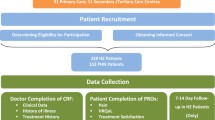Abstract
Herpes zoster manifests as a characteristic painful rash that resolves within 2 months of initial presentation in 90% of patients. As pain is a hallmark of the disease, the severity of an episode can be described by the magnitude and duration of pain. The Brief Pain Inventory (BPI) was used to follow the daily and weekly amount of pain reported by 50 patients with herpes zoster. Results demonstrate that the BPI is a reproducible, responsive and valid measure of pain due to herpes zoster. From the individual responses on the BPI, the area under the curve (AUC) for each patient was derived from the pain reported on sequential administrations of the BPI. This metric was simple to calculate, easy to explain and captured two dimensions of this episodic disease (magnitude and duration of pain) in a single continuous measure. AUC could prove useful in the application of patient response data to intervention trials in diseases that are of an episodic nature.
Similar content being viewed by others
References
ReulerJB, ChangMK. Herpes zoster: Epidemiology, clinical features, and management. South Med J 1984; 77: 1148–1156.
WoodMJ. Herpes zoster and pain. Scand J Infect 1991; 78 (Suppl.): 53–61.
Chang MN, Guess HA, Heyse JF. Reduction in burden of illness: A new efficacy measure for prevention trials. Stat Med. 1994.
CleelandCS. Assessment of pain in cancer: Measurement issues. Adv Pain Res Ther 1990; 16: 47–55.
DautRL, CleelandCS, FlanneryRS. Development of the Wisconsin brief pain questionnaire to assess pain in cancer and other diseases. Pain 1983; 17: 197–210.
StewartAL, HaysRD, WareJEJr. The MOS short-form general health survey: Reliability and validity in a patient population. Med Care 1988; 26: 724–735.
WareJEJr, SherbourneCD. The MOS 36-item short-form health survey (SF-36). I. Conceptual framework and item selection. Med Care 1992; 30: 473–483.
KirschnerB, GuyattG. A methodological framework for assessing health indices. J Chronic Dis 1985; 38: 27–38.
DeyoRA, DiehrP, PatrickDL. Reproducibility and responsiveness of health status measures: Statistics and strategies for evaluation. Controlled Clin Trials 1991; 12: 142S-158S.
RagozzinoMW, MeltonIIILJ, KurlandLT, ChuCP, PerryHO. Population-based study of herpes zoster and its sequelae. Medicine 1992; 61: 310–316
WareJEJr, SnowKK, KosinskiM, GandekB. SF-36 Health Survey: Manual and Interpretation Guide. Boston: The Health Institute, New England Medical Center, 1993.
GuyattGH, KirschnerB, JaeschkeR. Measuring health status: What are the necessary measurement properties? J Clin Epidemiol 1992; 45: 1341–1345.
Author information
Authors and Affiliations
Rights and permissions
About this article
Cite this article
Lydick, E., Epstein, R.S., Himmelberger, D. et al. Area under the curve: A metric for patient subjective responses in episodic diseases. Qual Life Res 4, 41–45 (1995). https://doi.org/10.1007/BF00434382
Received:
Accepted:
Issue Date:
DOI: https://doi.org/10.1007/BF00434382




